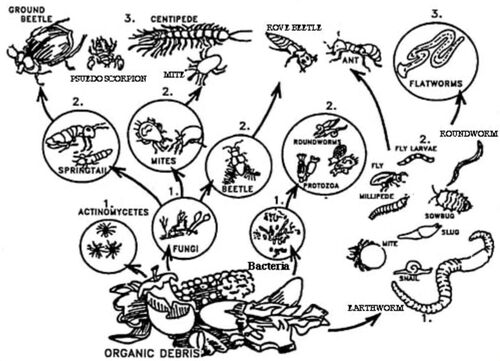Decomposers: Difference between revisions
Jump to navigation
Jump to search
| Line 3: | Line 3: | ||
[[File: 4C9E32BD-5427-4364-858F-FFB8652FAA35.jpeg|500px]] | [[File: 4C9E32BD-5427-4364-858F-FFB8652FAA35.jpeg|500px]] | ||
''' Figure 1 ''' Decomposers food web. [2] | ''' Figure 1 ''' Decomposers food web showing the energy transfer of decomposition. [2] | ||
= [[Diversity]] = | = [[Diversity]] = | ||
Revision as of 16:26, 1 April 2023
Decomposers are organisms which break down dead or decaying organic material. This most commonly includes bacteria, fungi, and invertebrates. The material broken down in decomposition is referred to as detritus. Detritus is matter composed of leaves and other plant parts, animal remains, waste products, and other organic debris that falls onto the soil or into bodies of water from surrounding terrestrial communities. [1]
Characteristics
Figure 1 Decomposers food web showing the energy transfer of decomposition. [2]
Diversity
Bacteria
Fungi
Invertebrates
Function
References
Citations
- Lotha, Gloria. “Detritus.” Encyclopædia Britannica, Encyclopædia Britannica, Inc., 15 May 2020, https://www.britannica.com/science/detritus.
- “Organisms in Composting.” Texas A&M AgriLife , Aggie Horticulture, Feb. 2009, https://aggie-horticulture.tamu.edu/earthkind/landscape/dont-bag-it/chapter-1-the-decomposition-process/. Accessed 1 Apr. 2023.
